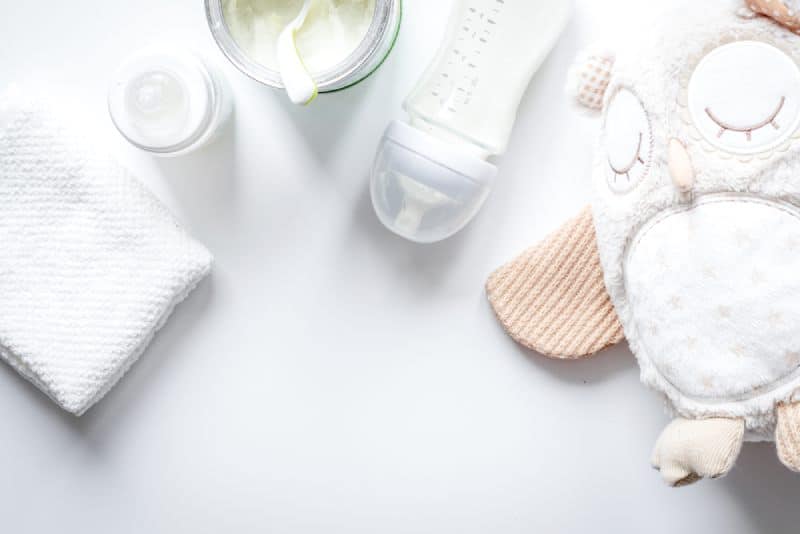Every breastfed baby will react and adapt differently when it comes to switching from breastmilk to formula. One important thing to watch out for is how your baby reacts to the changes.
Whether you are just supplementing your breast milk or transitioning from breastmilk to formula completely, it should be done gradually to make the transition as easy as possible for baby and you.
There are several reasons why moms introduce bottle-feeding or formula to their breastfed babies.
The reasons could be medical or for convenience. Moms may switch to formula for any number of reasons:
- low milk supply,
- desire to stop breastfeeding before a particular time (typically age 1),
- nighttime feedings or dream feedings, which result in lack of sleep and exhaustion,
- self-weaning before age 1,
- desire to get a cosmetic treatment like microblading and they don’t want to breastfeed during that time,
- inability to pump enough when mom is away from the baby, and
- baby’s inability to nurse efficiently.
When the baby’s teeth come in, some moms experience a lot of nipple biting which is another common reason to switch from breastfeeding to formula.

Whatever the reason for the transition from breastmilk to formula is, replacing breast milk suddenly with formula may not go down well with you or your little one.
If you’re wondering how to switch from breastmilk to formula, here are some tips to help you go through all of that easily.
1. Consult a pediatrician
Before making any change to your baby’s food selection, get professional advice from your baby’s pediatrician first.
It’s reassuring, especially for new moms, to have a professional’s backup when making new decisions that involve their baby.

Your doctor is able to provide helpful tips to help you introduce the formula and may recommend particular formulas to you.
If there are further concerns, especially about the formula they suggested, you can always consult them to get all your answers.
RELATED: Enfamil Vs Similac: Which Formula Is Better For Your Baby?
2. Offer expressed breast milk in a bottle
Getting breastfed babies to feed from a bottle that isn’t attached to their moms is one hard part of transitioning.
However, practice, overtime, makes perfect.
To get your baby to easily feed from a bottle, start by putting breast milk in it.
Once your baby gets used to feeding from a bottle, transitioning to formula will be a lot easier.
Also, make sure to choose the right baby bottle.
I recommend using baby bottles made out of special tempered glass because they’re durable, non-toxic and safe for the environment.
3. Make a gradual introduction
Take it easy when introducing formula at first. It’s necessary to test the field first and see how your baby reacts and adapts.
You can then switch completely if there’s no reaction, or your baby doesn’t seem to care much about what you are feeding him.

4. Direct baby’s attention to the bottle
It may seem tricky to get babies that have been breastfed to want milk that is not from their mom, especially considering the fact that babies can smell the breast milk from their moms.
To get such babies to bottle-feed, try to get their minds off you in the best way.
You can try telling a story, singing a song he loves, making a silly face, or anything else you can do to distract him, and then redirect his attention to the bottle.

5. Drop feeding sessions gradually
Making a smooth transition from breast milk to formula requires you to take things one step at a time. Drop one breastfeeding session and use formula instead.
For instance, if you breastfeed your little one eight times in 24 hours, go seven times on the breast and offer a bottle for the eighth feeding session.
Continue dropping breastfeeding sessions until your baby is weaned off breast milk.

6. Formula in the day
Babies may not want to stop getting bedtime and morning feeds even with the formula replacement.
Try feeding them formula in the daytime instead, when they are more alert, and maintain morning and bedtime nursing until they are completely weaned off breast milk.
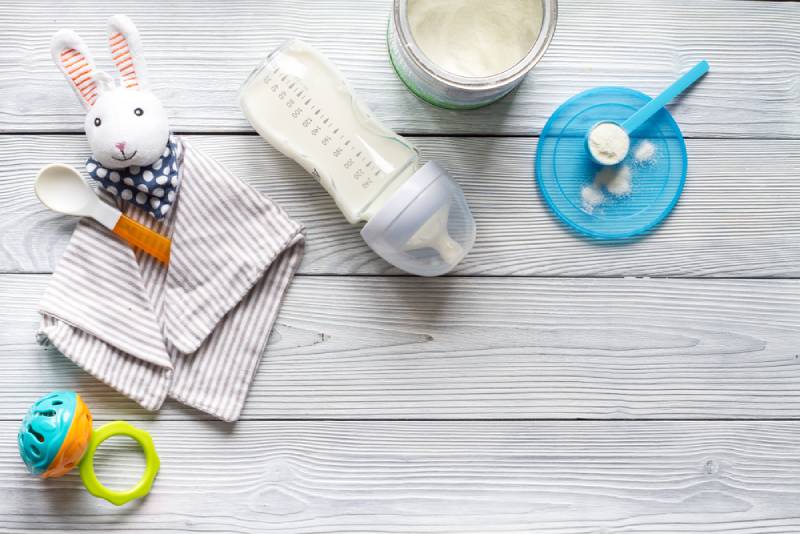
7. Offer formula when baby is actually hungry
When babies are actually hungry, they’ll take whatever you give them.
At such moments, your baby is unlikely to fight since he’s no other choice than to drink what he can get.
This looks like the perfect time to offer your little bundle a bottle.

8. Get a partner
Breastfed babies get so used to their moms being their only food source.
To change this, your baby needs to learn that other persons, apart from the mom, can feed him with a bottle.
A friend or your partner can help you feed your baby, and this will also keep him from getting distracted by your scent.

9. Mix breast milk and formula
If your baby isn’t taking to formula well, then you can try mixing your pumped milk with the formula to make a tasty mixture.
This is to create a smell and taste the baby is more familiar with, which in turn can help your little one adapt to the formula feeding better.
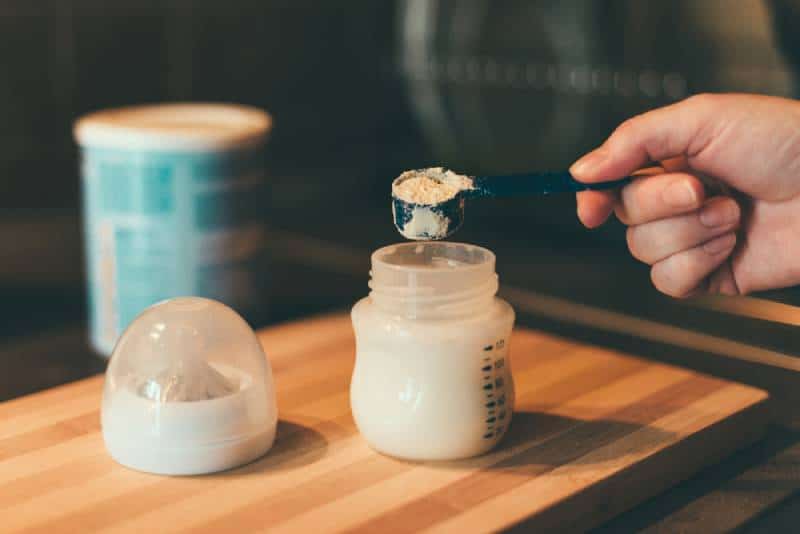
10. Bottle caps
One other reason why your baby may be finding it difficult to accept bottle feeding could be because of the cap, that is, the nipple or teat.
There are different kinds of bottle caps available with different lengths, widths, and textures to cater to every baby, even the fussiest.
So if your baby isn’t accepting the bottle, don’t give up just yet. Consider changing the nipple.
While switching from breast milk to formula, make sure to take note of changes. Is there a change in your baby’s stools, any skin flare-up, or mood change?
Look out for reactions and make notes to see what is normal and what isn’t. These notes are what will help your doctor provide solutions to help you if there’s an issue.
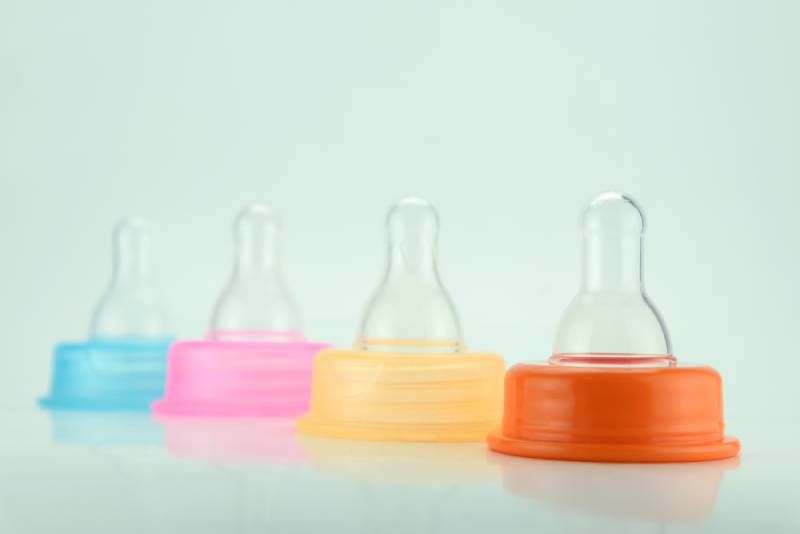
Mistakes Moms Make When Transitioning To Formula
1. Transitioning too quickly
Some moms may think that transitioning instantly is the best thing to do; nonetheless, this is not true. It’s a mistake not to transition slowly enough.
Your baby needs some time to learn to drink from a bottle and also get used to the taste of formula.
Also, unlike stopping breastfeeding cold turkey, slow transition prevents engorgement for mom.
Take about a full month to wean your little one off breast milk to have him feeding from a bottle comfortably.

2. Dropping too many feeding sessions at once
The next mistake moms make when transitioning is dropping several feeding sessions like it’s hot.
Decide which breastfeeding sessions to replace first – maybe the session that’s most inconvenient to you – and replace it with formula feeding.
Allow your baby to get used to that change before you drop the next one. It’s a “one step at a time” thing.
3. Keeping dad out of the picture
Since moms are the ones with breasts, the responsibility of nursing the baby falls on them.
However, when it’s time to switch to formula, let dad feed the baby the first bottle so as to enjoy some bonding time.
It will also make the process easier because the baby won’t be distracted by your presence and can simply focus on the bottle.
Also, it will reduce nursing stress for you, since you can get to rest while dad feeds the baby.
If dad isn’t in the picture, any relative can help.

4. Using the wrong nipple
Babies have their preferences, just like everyone else.
For example, instead of buying a set of Avent bottles or nipples, buy one first and check if your baby is okay with the nipple size.
Then if it works well, you can stock up. If not, on to the next.

5. Formula choice
The whole feeding schedule, nipple, and bottle considerations can easily distract moms from paying the needed attention to the formula itself, which is particularly important.
If your baby isn’t accepting the formula well, consider changing to a new formula.
In cases of allergies, your pediatrician can help recommend a formula that is best for your little one and his specific needs, like Nutramigen or Alimentum.
When allergies are severe, there are special baby formulas like Neocate or Elecare you can try.

6. Using old formula
Breast milk is always ready and never stale. However, the case is different with formula.
A bottle of formula that has been out in room temperature for over an hour is old.
Moms need to watch the clock to ensure that the formula in the bottle is still fresh enough for the baby to consume.
Feeding your baby old formula can make him sick.

7. Heating up of formula
Breastfeeding moms don’t have to think about heating up the milk before nursing, since the temperature of breast milk is always right for the baby.
But formula isn’t the same.
It’s common for moms introducing formula for the first time to get it wrong when trying to heat up formula to the same temperature as breast milk.
A baby-friendly formula should always be lukewarm, not warm or hot.
You can use water-based bottle warmers, or you can get the formula to the right temperature by setting it in a bowl of heated water and let the water heat the bottle up for you.
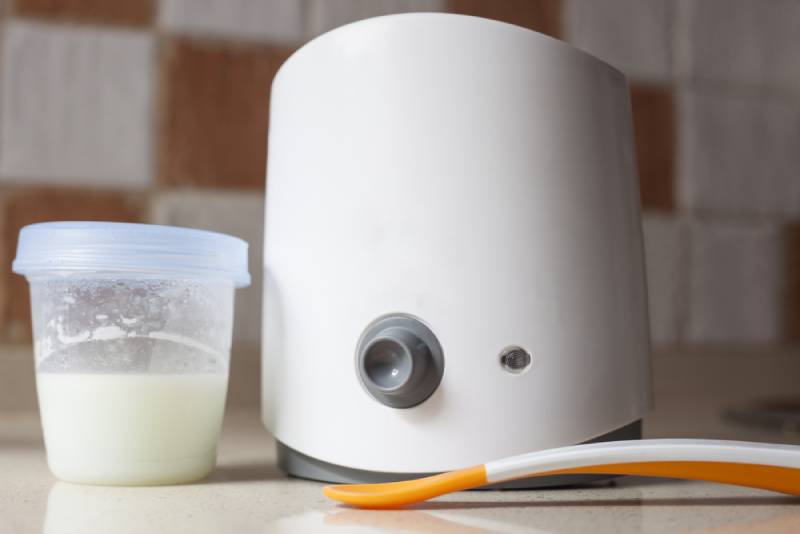
8. Force feeding the baby
No one enjoys been forced into anything. The same goes for babies and formula bottles. Force-feeding won’t help the switching process.
It could even make matters worse if your baby now associates anxiety and fear with the bottle.
Let your baby learn to use the bottle first and also get used to the taste of the formula, which is different from the breast milk your baby has known from birth.
The transition won’t happen overnight, so you need to be patient.

9. Not enough formula
A formula bottle would have to replace a full breastfeeding session for a proper transition.
You need to offer the right amount of formula for your baby to feel full, else he’ll still want to nurse some more.
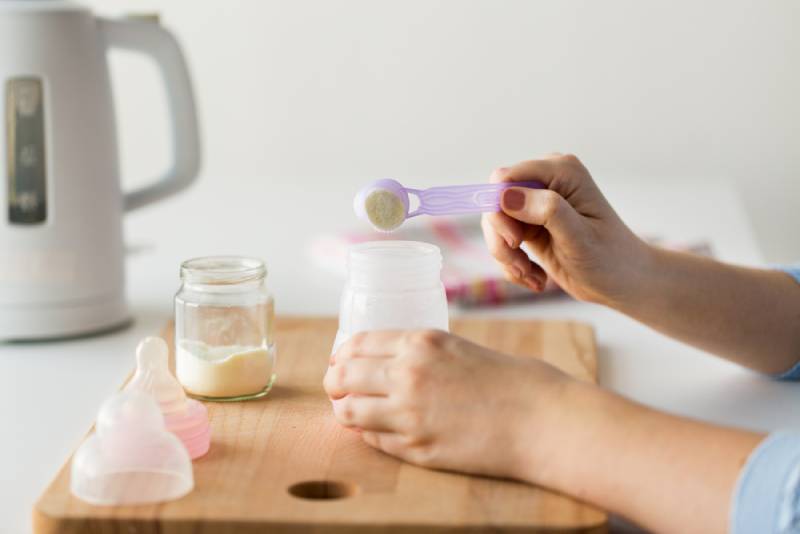
10. Too much formula
Just as too little formula is a transition mistake, too much is also not good.
Babies can overeat, since it’s easier for milk to flow from a formula bottle than the breast.
Overfeeding can lead to discomfort, excessive weight gain, gas, and spitting up.

11. Small midnight snack
Another mistake that throws the entire schedule off a little is the midnight snack you may allow your partner or relative to feed your baby to help him or her sleep while you get a little more yourself.
This way, your baby ingests too many calories.
Also, your baby may not be hungry by the next nursing session, which affects the nursing schedule.
Have your partner or relative cuddle the baby instead.

12. Giving in to guilt
Moms sometimes feel guilty when switching to formula.
However, there’s no reason for that. You don’t need to feel bad for using formula, since your baby is still getting fed.
If you make any mistakes along the way, try to correct it next time since you are better informed.

Extra Transition Tips
Switching from breast milk to formula is normal and completely healthy for your little one.
If you start feeling bad for bottle feeding your baby instead of breastfeeding, remember that your baby is getting all the nutrients he needs either way.
RELATED: Formula That Tastes Like Breast Milk (13 Best Choices)
However, if you still have concerns, these tips can help you:
- Add new activities to your routine to make up for the bonding time you miss. Try playing with your baby or reading interactive books together to foster that closeness.
- It’s easier to switch to baby formula after introducing solids to your baby’s routine. Your baby is already getting much of the nutrients he needs from the solids, so it could be easier to persuade him or her to take the formula along with the solids.
- Cow’s milk should wait until your baby is at least 1 year old because his body can’t process it earlier than then. Also, it doesn’t provide the needed nutrients your baby gets from formula or breast milk.

Introducing formula to your little one, whether to supplement breast milk or transition completely to formula, requires a lot of patience.
Understand that your baby needs time to adapt to the changes you are introducing, and that this transition cannot happen suddenly.
Hopefully, the tips discussed here will help you make a smooth transition.
Also, look out for any reactions and talk to your pediatrician or lactation consultant if you have more concerns.
READ NEXT: How Long Does A Can Of Formula Last? (+ Formula Storage Tips)
Like this article? Please share or pin it for later. You can also stay in the loop and follow us on Facebook, Instagram or Pinterest.
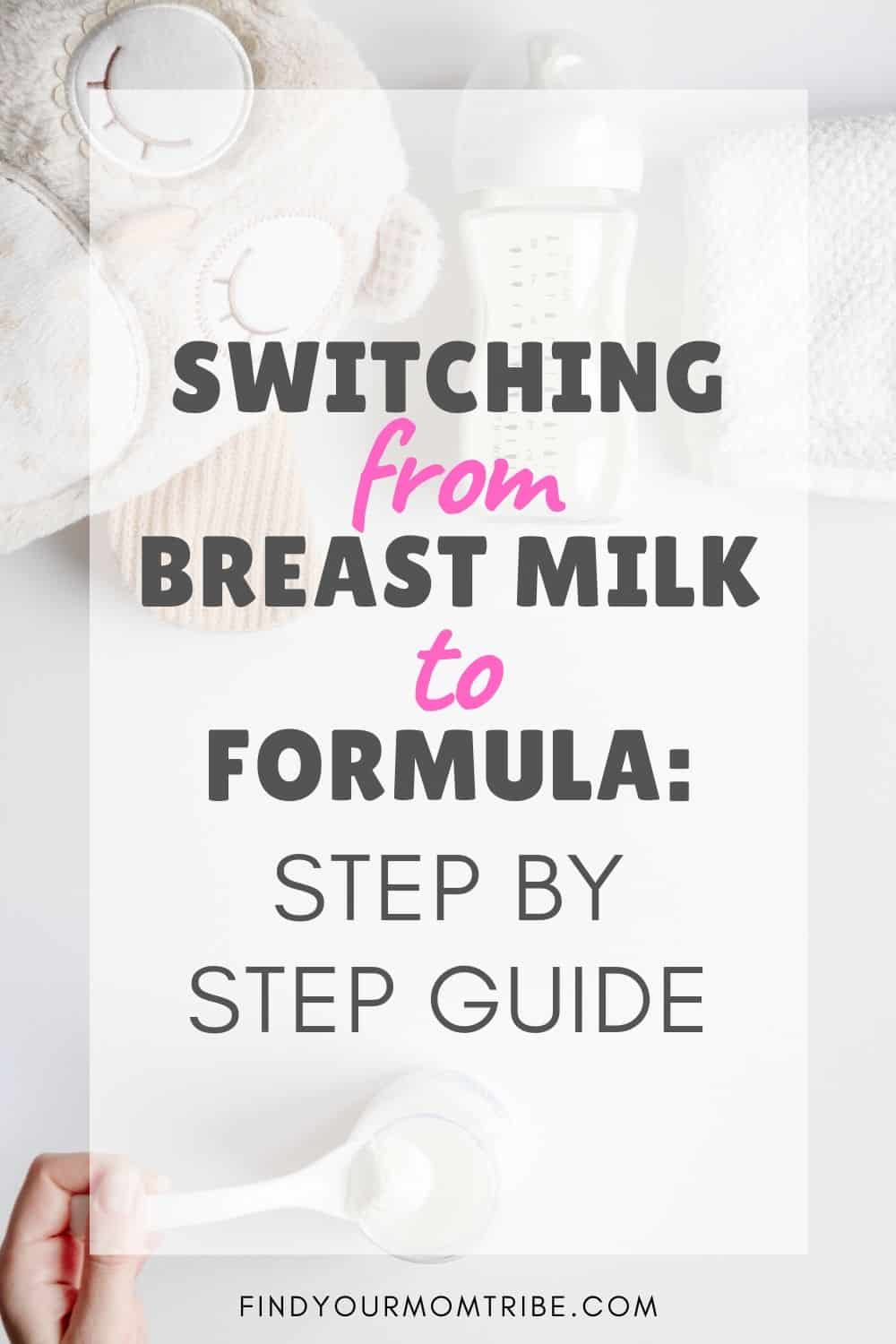
This post may contain affiliate links. Please see our full disclosure for more info.

